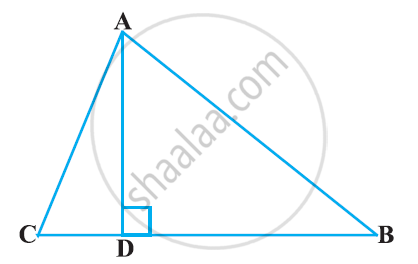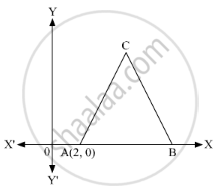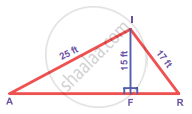Advertisements
Advertisements
Question
The sides of the triangle are given below. Find out which one is the right-angled triangle?
1.5, 1.6, 1.7
Solution
It is known that, if in a triplet of natural numbers, the square of the biggest number is equal to the sum of the squares of the other two numbers, then the three numbers form a Pythagorean triplet. If the lengths of the sides of a triangle form such a triplet, then the triangle is a right-angled triangle.
The sides of the given triangle are 1.5, 1.6, and 1.7.
Let us check whether the given set (1.5, 1.6, 1.7) forms a Pythagorean triplet or not.
The biggest number among the given set is 1.7.
(1.7)2 = 2.89; (1.5)2 = 2.25; (1.6)2 = 2.56
Now, 2.25 + 2.56 = 4.81 ≠ 2.89
∴ (1.5)2 + (1.6)2 ≠ (1.7)2
Thus, (1.5, 1.6, 1.7) does not form a Pythagorean triplet.
Hence, the given triangle with sides 1.5, 1.6, and 1.7 is not a right-angled triangle.
RELATED QUESTIONS
ABC is an equilateral triangle of side 2a. Find each of its altitudes.
The perpendicular from A on side BC of a Δ ABC intersects BC at D such that DB = 3CD . Prove that 2AB2 = 2AC2 + BC2.

In the given figure, ∆ABC is an equilateral triangle of side 3 units. Find the coordinates of the other two vertices ?

In ∆PQR, point S is the midpoint of side QR. If PQ = 11, PR = 17, PS = 13, find QR.
In right angle ΔABC, if ∠B = 90°, AB = 6, BC = 8, then find AC.
In the following figure, AD is perpendicular to BC and D divides BC in the ratio 1: 3.
Prove that : 2AC2 = 2AB2 + BC2
If the angles of a triangle are 30°, 60°, and 90°, then shown that the side opposite to 30° is half of the hypotenuse, and the side opposite to 60° is `sqrt(3)/2` times of the hypotenuse.
Find the Pythagorean triplet from among the following set of numbers.
4, 5, 6
In the figure, find AR
In ΔABC, if DE || BC, AD = x, DB = x – 2, AE = x + 2 and EC = x – 1, then value of x is ______.
